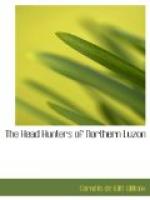We had hardly dismounted before the dancing began, in general against the sun, as elsewhere. Each rancheria of the many present had its dancers, and all made a display. One event, if the sporting term be permissible, seemed to be a sort of “follow-my-leader”; the motions, however, being confined to the circle, across which the file would go from time to time, thus differing from any other dance seen. In some cases, the step was bold and lively; in others, slow and stately, with arms outstretched. The gansa music was not nearly so well marked as that of the Ifugaos; it seemed to lack definition (an opinion advanced with some hesitation, and which a professional musician might not agree with). Sometimes women only appeared; in fact, up here the sexes did not mix in the dance. If we had remained longer in this part of the country, perhaps the differences and characteristics of this expression of native genius would have stood out more clearly; but in our short time, with so much dancing going on, impressions necessarily overlapped. And, in any case, shortly after our arrival, night fell, putting an end to the show, and we betook ourselves to our quarters; Captain Harris, of the local Constabulary forces, most kindly receiving some of us in his house.
Kalinga is neither a race nor a tribe name, but a word meaning “enemy” or “outlaw,” as though the hand of the people that bear it had been against everybody’s else. These people have been great head-hunters, and have not yet entirely abandoned the practice, though it is steadily diminishing. It should be recollected, however, that it is only within the last three or four years that we have had any relations with them, Mr. Worcester’s first visit to Lubuagan having occurred in 1907. On this occasion, immediately on arriving, he was shut up with his party in a house; and all night a lively debate went on outside as to whether the next morning his head should be taken or not, his native interpreter informing him of the progress of opinion as the night wore on.




